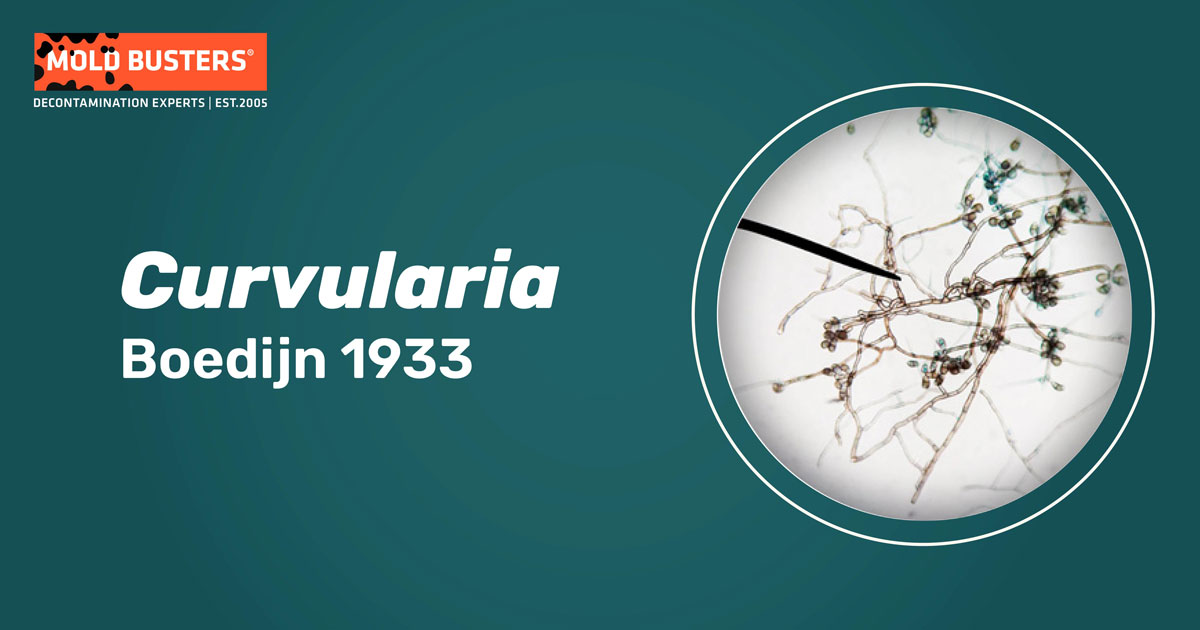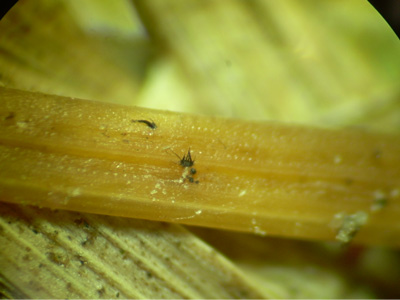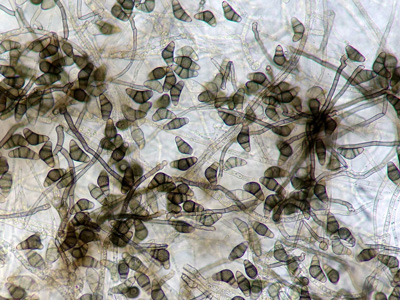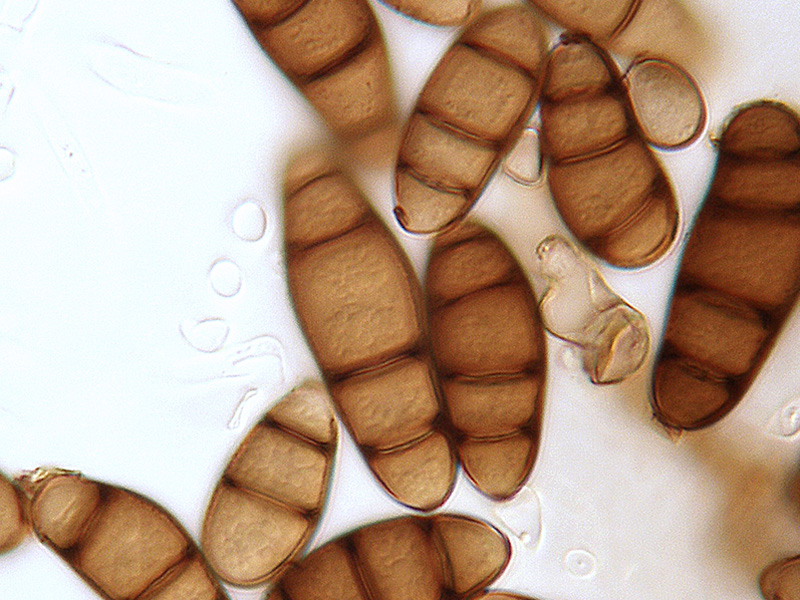Boedijn 1933
What is Curvularia?
Curvularia is a genus of fungi that mostly consists of plant pathogens. These organisms exist as grass pathogens or as saprobes occurring on plant material, dung, and soil. However, some are plant endophytes, and several species can be harmful to humans as well. Depending on the route of infection and immune status of the host, they range from mild superficial infections to severe invasive diseases. More than 10 species of this genus have been reported to cause opportunistic diseases in humans.
Curvularia can be found on all continents, with many species limited to the tropic and subtropical regions. They are of economic importance, as they can colonize important staple crops such as maize, wheat, and barley. Although it is primarily an outdoor fungus, Curvularia is often isolated from indoor building materials albeit mostly from wooden structures.

Curvularia species
The Curvularia genus contains about 80 species [1]. They are closely related to the Bipolaris genus, and several well-known and clinically relevant Bipolaris species have been transferred to the Curvularia genus in recent years (notably B. australiensis, B. hawaiiensis and B. spicifera) [2]. Curvularia species are anamorphs, and only asexualy reproduce. Their sexual stages are assigned to the Cochliobolus and Pseudocochliobolus genera [4].


Not counting these new additions, the species known to be pathogenic to humans are C. americana, C. brachyspora, C. chlamydospora, C. clavata, C. geniculata, C. hominis, C. inaequalis, C. lunata, C. muehlenbeckiae, C. pallescens, C. pseudolunata, C. senegalensis, and C. verruculosa [1, 3]. By far the most commonly occurring species in human infection is C. lunata [3].

Curvularia as a plant pathogen
Curvularia, along with their sexual states from the Cochliobolus genus can cause a wide range of serious plant diseases, particularly affecting cereals and grasses. Some species have caused significant plant epidemics on economically important crops such as barley, maize, rice, sorghum, and wheat. These have resulted in significant yield losses, with some researchers estimating the annual losses to be up to $US 10 billion annually [5].
Being a grass pathogen, Curvularia can affect garden plants and lawns, especially in warmer climates. Lawn grass can dry out despite frequent watering and can thin out or become patchy. The leaves of other plants turn yellow and brown from the tip down or start to show lightly colored spots.
Curvularia infection and disease
Curvularia fungi can cause several opportunistic infections in humans. Apart from causing relatively harmless issues concerning the skin and nails, Curvularia spp. are often associated with cases of fungal sinusitis and keratitis, and are the third most prevalent cause of fungal keratitis in certain regions of the USA [6].
Curvularia can also cause endocarditis (infection of the inner lining of the heart chambers and valves), peritonitis, mycetoma, pulmonary infection, cerebral infection, and subcutaneous phaeohyphomycosis [3].
Serious infections usually occur in immunocompromised individuals, such as patients suffering from AIDS, undergoing chemotherapy, or those on immunosuppressive medication due to an organ transplant. Despite this fact, even completely healthy people have been known to develop invasive diseases related to Curvularia [7]. Most mold-related health issues arise from spore exposure, mostly by inhalation.
At first, mold growth on a wall may seem harmless. However, upon maturation, mold releases many thousands of airborne spores. These spores float in the air and are inhaled by humans and animals daily. They are usually dealt with promptly by the immune system. However, if the immune system fails to detect inhaled spores, they will germinate and cause mycosis. Therefore, it is best to keep the spore exposure to a minimum as a high amount of spores can cause immune and respiratory problems even in healthy individuals.
Curvularia spores are relatively large and their spores therefore often remain in the nose or sinus after inhalation. Rarely, a chronic, allergic sinusitis may be provoked in patients with existing allergic rhinitis (hay fever) [8]. C. lunata especially is known to cause allergic reactions in humans and shares allergenic components with other fungal allergens such as Alternaria alternata and Epicoccum nigrum [9].
Curvularia treatment
Treatment of Curvularia infections depends on the site of infection. Diseases of the skin and nails may be treated by the use of antifungal creams or powders. Serious invasive infections usually require oral therapy. However, the optimal antifungal therapy for Curvularia infection is not known, and responses to treatment with amphotericin B, miconazole, ketoconazole, terbinafine, and itraconazole have been reported [10].
How to identify Curvularia?
Curvularia molds are described as rapidly growing, woolly or velvety to the touch and gray to grayish-black or brown. They are most likely to be found in damp areas of the home, such as bathrooms and kitchens (especially areas under sinks), window frames, leaky roofs, or moist basements. They usually colonize wooden structures.
Curvularia is almost impossible to identify without professional help. As with most molds, they can only be identified by their conidia, by culture, or through DNA analysis.
How to remove Curvularia?
If you happen to observe any mold growth in your home or office, you should get it removed as soon as possible. Most types of indoor mold can pose a threat to human health, especially to people who have underlying pulmonary issues, weakened immune systems, or those who frequently suffer from allergies.
Mold can be extremely persistent and troublesome to remove. In most cases, underlying issues such as leaky pipes or other moisture-related construction issues need to be dealt with to remove the mold once and for all. If these issues remain, the mold will eventually return as there is no way of entirely removing mold spores from the air. Therefore, humidity problems are a priority, as most molds need proper moisture levels to develop.
You can attempt to remove the mold on your own but undertaking any mold removal yourself is not advisable without appropriate protective clothing and headgear. Any agitation of the mold will release a massive number of spores into the air and inhaling fungal spores in such a large concentration can have adverse effects on even the healthiest person.
In most cases, mold removal is best left to the professionals. At Mold Busters we have an experienced team of technicians that have the technology and the know-how to remove mold infestations of any scale.
We offer a comprehensive set of services, including air sampling, dehumidifying, mold testing, and mold removal.
In addition, we can point out any underlying issues that need fixing and give advice on the steps that need to be taken in order to make your residence mold-free for the foreseeable future. Call us today to book an appointment.

Did you know?
Stachybotrys is the 2nd common toxic mold type found in homes we tested?! Find out more exciting mold stats and facts on our mold statistics page.
References
- Ellis D (2016). Curvularia. Retrieved from mycology.adelaide.edu.au.
- Manamgoda DS, Cai L, McKenzie EHC, Crous PW, Madrid H, Chukeatirote E, Shivas RG, Tan YP, Hyde KD (2012). A phylogenetic and taxonomic re-evaluation of the Bipolaris–Cochliobolus–Curvularia complex. Fungal Diversity 56: 131–144.
- Howard DH (2003). Pathogenic Fungi in Humans and Animals. Marcel Dekker, New York. pp 582-586.
- Madrid H, da Cunha KC, Gené J, Dijksterhuis J, Cano J, Sutton DA, Guarro J, Crous PW (2014). Novel Curvularia species from clinical specimens. Persoonia. 33:48-60.
- Bengyella L, Iftikhar S, Nawaz K, Fonmboh DJ, Yekwa EL, Jones RC, Njanu YMT, Roy P (2019). Biotechnological application of endophytic filamentous bipolaris and Curvularia: a review on bioeconomy impact. World J Microbiol Biotechnol. 35(5):69.
- Wilhelmus KR, Jones DB (2001). Curvularia keratitis. Trans Am Ophthalmol Soc. 99: 111–32.
- Ebright JR, Chandrasekar PH, Marks S, Fairfax MR, Aneziokoro A, McGinnis MR (1999). Invasive sinusitis and cerebritis due to Curvularia clavata in an immunocompetent adult. Clin Infect Dis. 28(3):687-9.
- MacMillan RH 3rd, Cooper PH, Body BA, Mills AS (1987). Allergic fungal sinusitis due to Curvularia lunata. Hum Pathol. 18(9):960-4.
- Gupta R, Singh BP, Sridhara S, Gaur SN, Kumar R, Chaudhary VK, Arora N (2002). Allergenic cross-reactivity of Curvularia lunata with other airborne fungal species. Allergy. 57(7):636-40.
- Safdar A (2003). Curvularia – favorable response to oral itraconazole therapy in two patients with locally invasive phaeohyphomycosis. Clin Microbiol Infect. 9(12):1219-23.

Get Special Gift: Industry-Standard Mold Removal Guidelines
Download the industry-standard guidelines that Mold Busters use in their own mold removal services, including news, tips and special offers:

Written by:
John Ward
Account Executive
Mold Busters
Edited by:
Dusan Sadikovic
Mycologist – MSc, PhD
Mold Busters
